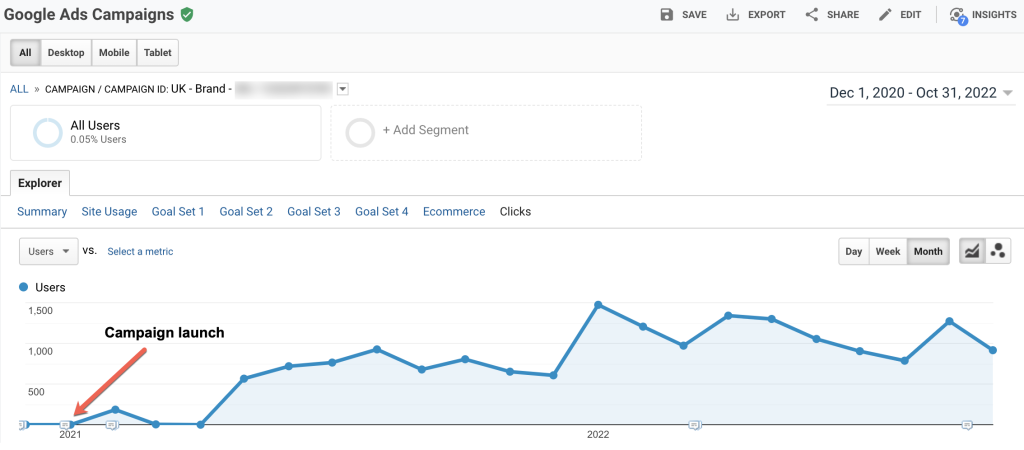Let me start with this: I’ve run a successful paid media agency for more than a decade because we drive leads for our clients.
Not only do we drive leads, but we often increase them month after month, year after year.
And yet, it’s not always about leads, people.
There’s a lot that needs to happen before you can get leads in the door—especially when promoting a new product.

In the past week, I’ve been reminded that senior managers and directors—marketing experts in their own right—often have a difficult time explaining to their executives the work that has to come BEFORE you get to the lead stage with new products.
The challenge with new products is that… they’re new. People don’t know about them, so they aren’t searching for your branded terms. New products have low search volumes. Just because you’re bidding on your product name doesn’t mean your ad will impression.
It’s a concept almost everyone can agree on in theory. But things often fall apart in the application.
Let me explain with a couple of real-life examples.
Promoting an industrial manufacturer’s new product
One of our long-time clients, an industrial manufacturer, set aside an additional $5k to promote a new product.
This product is something very unique to their industry. Let’s call it “Factory Product A.”
No one was searching for Factory Product A. Consequently, keyword-targeted campaigns and dynamic search ads weren’t impressioning. However, based on our experience, we knew we could increase impressions, clicks, and leads by building a Google Ads program that built awareness and demand over time.
How do we typically do this? Some of our go-to strategies include video ads and display ads, using various targeting methods.
We like these ad formats because they’re both very visual—which helps when introducing a new product. Video in particular is a great way to showcase a new product, how it works, and the value it brings.
We also tend to use these two targeting methods to increase demand:
1. Customer match campaigns
Customer match targeting is a great way to reconnect with past buyers and/or target specific customer segments that are good candidates for a new product.
Because this audience is built from your customer list (i.e. first-party data) it’s an amazingly well-targeted option.
2. Custom segment campaigns
Custom segments targeting allows you to leverage audiences of competitor sites and pages that sell similar products. You can enter URLs that your ideal customer might frequent, and your ads will target people who browse similar websites.
We applied these methods with our industrial client. One month into our efforts, things looked very promising. We didn’t have any leads (yet) but our ads were starting to impression for our branded terms (i.e. brand name + product-related keywords).
This was a HUGE win that demonstrated our efforts were working.
Our clients agreed this was good progress… but guess what? A few days later, our budget was cut. Higher-up executives had concluded that our efforts were unsuccessful because they hadn’t generated any leads yet—ignoring the fact that we’d laid important groundwork that would pay dividends for years if we continued.
It’s too bad. My feeling is that if we’d stuck with the plan for another 30 or 60 days, the outcome could have been quite different.
Promoting a new product line
I recently made a sales presentation to a company that had just acquired a robotics company.
The company that made the acquisition is well-known, but not for robotics. They wanted to get leads for their new acquisition.
I explained what we would do to build demand, and the marketing team nodded along in agreement. Meanwhile, the VP of sales kept asking, “How many leads will we get?”
It’s a valid question—and one I would ask too if I were vetting a new Google Ads agency!
But how do you answer that question when the product is new—and you need to lay some groundwork? How can you demonstrate that what you’re doing is working?
The answer lies in looking at metrics that lie outside of lead count, such as:
- Landing page views and engagement—and how they evolve over time
- Video ad engagement—such as watch-time on explainer videos
- Impressions and search volume for the branded product name and related terms.
When you pay attention to these metrics, you can see your efforts take shape.
Here’s an example from a different client:

As you can see, clicks have improved fairly consistently over the past couple of years for our branded product terms from the time we launched in December 2019 to today. We went from zero to as many as 1,500 users in one month.
You have to lay the foundation for leads to grow
Of course, leads are important. But when your product is new, you have to introduce your product to your target audience first.
And that means strategically using specific ad formats and audience targeting methods to build that awareness—and create an environment where leads will grow.






